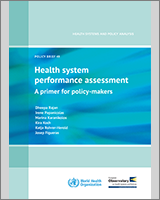Health system performance assessment
Policy Brief, No. 49
Authors
Dheepa Rajan,1 Irene Papanicolas,2 Marina Karanikolos,3 Kira Koch,4 Katja Rohrer-Herold,4 and Josep Figueras1.Affiliations
Key messages
Increasing health system performance is critical in creating resilient health systems. If health policies are to foster the ability to withstand shocks like the COVID-19 pandemic, they need to focus on the right interventions that strengthen health systems – those that improve performance.
- Assessing the performance of a health system effectively is the first step to improving it.
- This requires a conceptual lens through which to view the health system structures, its inputs and the outputs and outcomes that they feed into.
- The Health System Performance Assessment (HSPA) Framework for Universal Health Coverage (UHC) offers policy-makers a conceptual tool to assess performance effectively.
- It provides a rigorous description of the four health system functions – governance, resource generation, financing and service delivery – and their sub-functions that matter most for the function-level and overall system performance.
- It builds on existing tools and frameworks but orients the analysis of health system assessment exercises towards system performance.
- It identifies impacts on health system performance and encourages operational focus.
- The HSPA Framework for UHC has real-world applications and helps direct policy action.
- It allows policy-makers to understand how the health system works and how its functions and sub-functions are linked to the “assessment areas” that explain performance.
- It provides an explanation of the health system bottlenecks that contribute to specific policy challenges.
- This will support efforts to pinpoint the person, group or institution that can and should take responsibility for remedial action and promote accountability.
- Its insights into the governance function will help policy-makers to use governance as a lever to achieve health system goals.
About the Series
All rights reserved. The Regional Office for Europe of the World Health Organization welcomes requests for permission to reproduce or translate its publications, in part or in full.
The designations employed and the presentation of the material in this publication do not imply the expression of any opinion whatsoever on the part of the World Health Organization concerning the legal status of any country, territory, city or area or of its authorities, or concerning the delimitation of its frontiers or boundaries.
The mention of specific companies or of certain manufacturers’ products does not imply that they are endorsed or recommended by the World Health Organization in preference to others of a similar nature that are not mentioned. Errors and omissions excepted, the names of proprietary products are distinguished by initial capital letters.
All reasonable precautions have been taken by the World Health Organization to verify the information contained in this publication. However, the published material is being distributed without warranty of any kind, either express or implied. The responsibility for the interpretation and use of the material lies with the reader. In no event shall the World Health Organization be liable for damages arising from its use. The views expressed by authors, editors, or expert groups do not necessarily represent the decisions or the stated policy of the World Health Organization.
Box
What is a Policy Brief?
